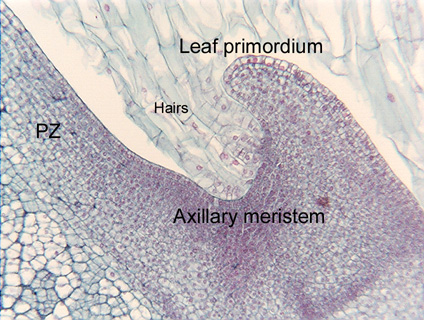 Fig. 6.3-7c.
Magnification of a cactus apical meristem (Oroya depressa). This shows
the peripheral zone, a leaf primordium and a developing axillary bud. In this
large apical meristem, the peripheral zone is, relatively speaking, huge. It is
many layers thick and extends for dozens of cells between the CMC zone and the
leaf primordium. Because this apical meristem is so large, many leaf primordia
can fit on its margin, so the leaf primordium visible here (the same one shown
in Fig. 6.3-7a) may actually be quite old, even though it is the uppermost
primordium visible in the median longitudinal section -- the apex may have many
younger primordia that were microtomed away on the back or front sides. The
axillary meristem here is still organizing itself, and has not yet started to
produce its own leaf primordia, but when it does, they will develop as spines
rather than as ordinary leaves or bud scales.
Fig. 6.3-7c.
Magnification of a cactus apical meristem (Oroya depressa). This shows
the peripheral zone, a leaf primordium and a developing axillary bud. In this
large apical meristem, the peripheral zone is, relatively speaking, huge. It is
many layers thick and extends for dozens of cells between the CMC zone and the
leaf primordium. Because this apical meristem is so large, many leaf primordia
can fit on its margin, so the leaf primordium visible here (the same one shown
in Fig. 6.3-7a) may actually be quite old, even though it is the uppermost
primordium visible in the median longitudinal section -- the apex may have many
younger primordia that were microtomed away on the back or front sides. The
axillary meristem here is still organizing itself, and has not yet started to
produce its own leaf primordia, but when it does, they will develop as spines
rather than as ordinary leaves or bud scales.